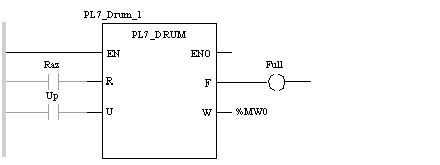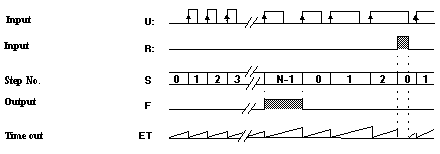|
Description
|
|
|
Original instructions
|


CAL PL7_Drum_1(R := Raz, U := Up, F => Full, W => %MW0)
IF Raz THEN
RESET_PL7_DRUM(PL7_Drum_1);
END_IF ;
IF RE (Up) THEN
UP_PL7_DRUM(PL7_Drum_1);
END_IF ;
Full := PL7_Drum_1.F ;
%MW0 := PL7_Drum_1.W ;
|
Parameter
|
Type
|
Comment
|
|---|---|---|
|
R
|
"Return to step 0" input, at state 1 initializes the drum at step 0.
|
|
|
U
|
"Advance" input, on rising edge causes the drum to advance by one step and the updating of the order bits.
|
|
Parameter
|
Type
|
Comment
|
|---|---|---|
|
F
|
Output indicating that the final step defined is in progress.
|
|
|
W
|
Current step output value.
|
|
Parameter
|
Type
|
Comment
|
|---|---|---|
|
LEN
|
Number of steps: possible values from 1 to 16 (default is 16).
|
|
|
ET
|
Time out or duration of current step. PL7_Drum_1.ET is between 0 and 9999. This integer can be reset to zero for each step change. It can be read and tested, but not written. The duration of a step is equal to PL7_Drum1.ET x PL7_Drum_1.TB.
|
|
|
S
|
Between 0 and 15, this is the number of the current step. This integer can be read and tested. It can only be written from an immediate value.
|
|
|
TB
|
Cyclical programmer time base. Possible values:
When the program is executed, the value of the time base (TB defined in offline mode) is rounded down to the nearest multiple of 2 (between 1 and 8).
|
|
|
W0...Wj
(j=LEN-1)
|
PL7_Drum_1.Wj is a word representing the state of step j. This word (type INT) indicates the state of each order bit for a given step. It is entered by the user using the data editor.
Note: There are as many Wj as there are steps (LEN).
|
 CAUTION CAUTION |
|
UNEXPECTED BEHAVIOR AFTER WARM RESTART
Do no modify the time base (TB) in online mode, this would cause an unexpected behavior of the application on warm restart.
Failure to follow these instructions can result in injury or equipment damage.
|
